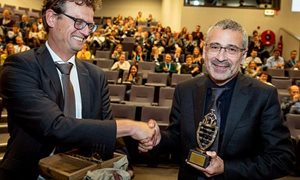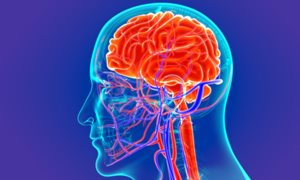 Researchers of Radboudumc have discovered that the iron in metal surgical implants can activate drugs such as antibiotics, thus enabling targeted therapy. With this method, antibiotics in the blood can target infections in the vicinity of an implant, write researchers Marja Bulte-ter Meer and Leo Schultze Kool in Chemical Communications.
Researchers of Radboudumc have discovered that the iron in metal surgical implants can activate drugs such as antibiotics, thus enabling targeted therapy. With this method, antibiotics in the blood can target infections in the vicinity of an implant, write researchers Marja Bulte-ter Meer and Leo Schultze Kool in Chemical Communications.
Enzyme-prodrug therapy
It is therefore more effective if drugs are active only in the vicinity of the implant, for example by administering the drug locally. One method to achieve this is known as enzyme-prodrug therapy (EPT). Patients receive inactive drugs – prodrugs – which can be converted into active drugs in the body. But for this work, the implant has to contain the enzymes needed for this conversion.
Discovered by accident
Marja Bulte-ter Meer, a PhD candidate working with Professor of Interventional Radiology Leo Schultze Kool of Radboudumc, discovered by accident that a certain type of widely used metal implant has an enzyme-like effect. This enables the implants to cleave sugar groups from molecules. This mechanism can be used for drug treatment by adding a sugar group to a drug, which results in a prodrug. As soon as the sugar group is cleaved from the molecule, the drug becomes active.
Grooves
The researchers made their discovery when working with implants consisting of an alloy of cobalt, nickel, chromium and molybdenum. The implants themselves were inert, but a version with small grooves in the metal had strong activity in cleaving sugar groups. On closer inspection it appeared that iron had been deposited in these grooves. This iron turned out to be responsible for the efficient conversion of the drugs to their active form. The underlying mechanism for this process is not yet known.
Pure iron
Implants of pure iron would work best with enzyme-prodrug therapy. However, pure iron is chemically instable and cannot be used to make implants. The researchers therefore thought it would be a better idea to provide existing implants with an iron coating. Laboratory tests have shown that various implant materials with an iron coating can effectively convert an antibiotic pro-drug to an active drug.
Patent
During the past 18 months, Bulte-ter Meer and Schulze Kool have developed their discovery in collaboration with Aarhus University (Denmark) and implant manufacturer Fort Wayne Medical. The researchers have now applied for a patent on the enzymatic function of metallic implants. As a result, this technique can be used extensively for a wide range of drugs.
Marja Bulte - ter Meer is member of theme Rare cancers.
Leo Schultze Kool is member of theme Vascular damage.
Related news items

Grants for heart and kidney research Two awards to Radboudumc in Open Competition ENW-XS
21 July 2022Two researchers from the Radboudumc receive a grant from the NWO within the Open Competition of the Exact and Natural Sciences. They are Thijs Eijsvogels, who studies the heart, and Pieter Leermakers, who studies the kidneys.
go to page
Your heart rate as a thermometer Research Olympic athletes will be followed up during 4Daagse
18 July 2022Body temperature can be determined from heart rate. This is what research by the Radboudumc among Olympic athletes shows. Athletes can use this method during training to eventually perform better in the heat. The technique is now being further investigated among participants in the 4Daagse.
go to page
Report of the 12th New Frontiers symposium Big data, better healthcare? - 1 November 2018
7 November 2018 Examples from the application of deep learning to image reading in pathology and radiology and the application of network medicine to monitor infectious disease outbreaks or collective mood states using twitter data showed the huge potential of big data approaches for building better healthcare. go to page


